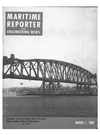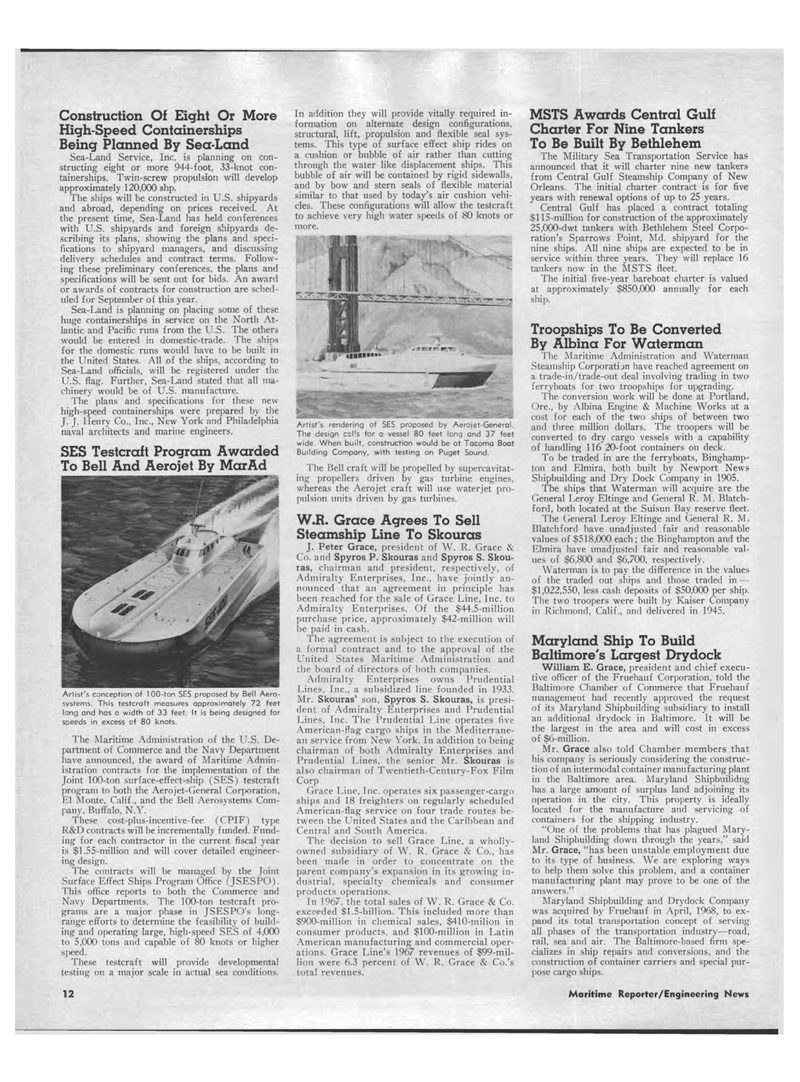
Page 10: of Maritime Reporter Magazine (March 1969)
Read this page in Pdf, Flash or Html5 edition of March 1969 Maritime Reporter Magazine
Construction Of Eight Or More High-Speed Containerships Being Planned By Sea-Land Sea-Land Service, Inc. is planning on con-structing eight or more 944-foot, 33-knot con-tainerships. Twin-screw propulsion will develop approximately 120,000 shp. The ships will be constructed in U.S. shipyards and abroad, depending on prices received. At the present time, Sea-Land has held conferences with U.S. shipyards and foreign shipyards de-scribing its plans, showing the plans and speci-fications to shipyard managers, and discussing delivery schedules and contract terms. Follow-ing these preliminary conferences, the plans and specifications will be sent out for bids. An award or awards of contracts for construction are sched-uled for September of this year. Sea-Land is planning on placing some of these huge containerships in service on the North At-lantic and Pacific runs from the U.S. The others would be entered in domestic-trade. The ships for the domestic runs would have to be built in the United States. All of the ships, according to Sea-Land officials, will be registered under the U.S. flag. Further, Sea-Land stated that all ma-chinery would be of U.S. manufacture. The plans and specifications for these new high-speed containerships were prepared by the J. J. Henry Co., Inc., New York and Philadelphia naval architects and marine engineers. SES Testcraft Program Awarded To Bell And Aerojet By MarAd Artist's conception of 100-ton SES proposed by Bell Aero-systems. This testcraft measures approximately 72 feet long and has a width of 33 feet. It is being designed for speeds in excess of 80 knots. The Maritime Administration of the U.S. De-partment of Commerce and the Navy Department have announced, the award of Maritime Admin-istration contracts for the implementation of the Joint 100-ton surface-effect-ship (SES) testcraft program to both the Aerojet-General Corporation, El Monte, Calif., and the Bell Aerosystems Com-pany. Buffalo, N.Y. These cost-plus-incentive-fee (CPIF) type R&D contracts will be incrementally funded. Fund-ing for each contractor in the current fiscal year is $1.55-million and will cover detailed engineer-ing design. The contracts will be managed by the Joint Surface Effect Ships Program Office (JSESPO). This office reports to both the Commerce and Navy Departments. The 100-ton testcraft pro-grams are a major phase in JSESPO's long-range efforts to determine the feasibility of build-ing and operating large, high-speed SES of 4,000 to 5,000 tons and capable of 80 knots or higher speed. These testcraft will provide developmental testing on a major scale in actual sea conditions. In addition they will provide vitally required in-formation on alternate design configurations, structural, lift, propulsion and flexible seal sys-tems. This type of surface effect ship rides on a cushion or bubble of air rather than cutting through the water like displacement ships. This bubble of air will be contained by rigid sidewalls, and by bow and stern seals of flexible material similar to that used by today's air cushion vehi-cles. These configurations will allow the testcraft to achieve very high water speeds of 80 knots or more. site aSSWiSI Artist's rendering of SES proposed by Aerojet-General. The design calls for a vessel 80 feet long and 37 feet wide. When built, construction would be at Tacoma Boat Building Company, with testing on Puget Sound. The Bell craft will be propelled by supercavitat-ing propellers driven by gas turbine engines, whereas the Aerojet craft will use waterjet pro-pulsion units driven by gas turbines. W.R. Grace Agrees To Sell Steamship Line To Skouras J. Peter Grace, president of W. R. Grace & Co. and Spyros P. Skouras and Spyros S. Skou-ras, chairman and president, respectively, of Admiralty Enterprises, Inc., have jointly an-nounced that an agreement in principle has been reached for the sale of Grace Line, Inc. to Admiralty Enterprises. Of the $44.5-million purchase price, approximately $42-million will be paid in cash. The agreement is subject to the execution of a formal contract and to the approval of the United States Maritime Administration and the board of directors of both companies. Admiralty Enterprises owns Prudential Lines. Inc., a subsidized line founded in 1933. Mr. Skouras' son, Spyros S. Skouras, is presi-dent of Admiralty Enterprises and Prudential Lines, Inc. The Prudential Line operates five American-flag cargo ships in the Mediterrane-an service from New York. In addition to being chairman of both Admiralty Enterprises and Prudential Lines, the senior Mr. Skouras is also chairman of Twentieth-Century-Fox Film Corp. Grace Line, Inc. operates six passenger-cargo ships and 18 freighters on regularly scheduled American-flag service on four trade routes be-tween the United States and the Caribbean and Central and South America. The decision to sell Grace Line, a wholly-owned subsidiary of W. R. Grace & Co., has been made in order to concentrate on the parent company's expansion in its growing in-dustrial, specialty chemicals and consumer products operations. In 1967. the total sales of W. R. Grace & Co. exceeded $1.5-billion. This included more than $900-million in chemical sales, $410-milion in consumer products, and $100-million in Latin American manufacturing and commercial oper-ations. Grace Line's 1967 revenues of $99-mil-lion were 6.3 percent of W. R. Grace & Co.'s total revenues. MSTS Awards Central Gulf Charter For Nine Tankers To Be Built By Bethlehem The Military Sea Transportation Service has announced that it will charter nine new tankers from Central Gulf Steamship Company of New Orleans. The initial charter contract is for five years with renewal options of up to 25 years. Central Gulf has placed a contract totaling $115-million for construction of the approximately 25,000-dwt tankers with Bethlehem Steel Corpo-ration's Sparrows Point, Md. shipyard for the nine ships. All nine ships are expected to be in service within three years. They will replace 16 tankers now in the MSTS fleet. The initial five-year bareboat charter is valued at approximately $850,000 annually for each ship. Troopships To Be Converted By Albina For Waterman The Maritime Administration and Waterman Steamship Corporati jn have reached agreement on a trade-in/trade-out deal involving trading in two ferryboats for two troopships for upgrading. The conversion work will be done at Portland, Ore., by Albina Engine & Machine Works at a cost for each of the two ships of between two and three million dollars. The troopers will be converted to dry cargo vessels with a capability of handling 116 20-foot containers on deck. To be traded in are the ferryboats, Binghamp-ton and Elmira, both built by Newport News Shipbuilding and Dry Dock Company in 1905. The ships that Waterman will acquire are the General Leroy Eltinge and General R. M. Blatch-ford, both located at the Suisun Bay reserve fleet, The General Leroy Eltinge and General R. M, Blatchford have unadjusted fair and reasonable values of $518,000 each; the Binghampton and the Elmira have unadjusted fair and reasonable val-ues of $6,800 and $6,700, respectively. Waterman is to pay the difference in the values of the traded out ships and those traded in ? $1,022,550, less cash deposits of $50,000 per ship. The two troopers were built by Kaiser Company in Richmond, Calif., and delivered in 1945. Maryland Ship To Build Baltimore's Largest Drydock William E. Grace, president and chief execu-tive officer of the Fruehauf Corporation, told the Baltimore Chamber of Commerce that Fruehauf management had recently approved the request of its Maryland Shipbuilding subsidiary to install an additional drydock in Baltimore. It will be the largest in the area and will cost in excess of $6-million. Mr. Grace also told Chamber members that his company is seriously considering the construc-tion of an intermodal container manufacturing plant in the Baltimore area. Maryland Shipbuilidng has a large amount of surplus land adjoining its operation in the city. This property is ideally located for the manufacture and servicing of containers for the shipping industry. "One of the problems that has plagued Mary-land Shipbuilding down through the years," said Mr. Grace, "has been unstable employment due to its type of business. We are exploring ways to help them solve this problem, and a container manufacturing plant may prove to be one of the answers." Maryland Shipbuilding and Drydock Company was acquired by Fruehauf in April, 1968, to ex-pand its total transportation concept of serving all phases of the transportation industry?road, rail, sea and air. The Baltimore-based firm spe-cializes in ship repairs and conversions, and the construction of container carriers and special pur-pose cargo ships. 12 Maritime Reporter/Engineering News

 9
9

 11
11
